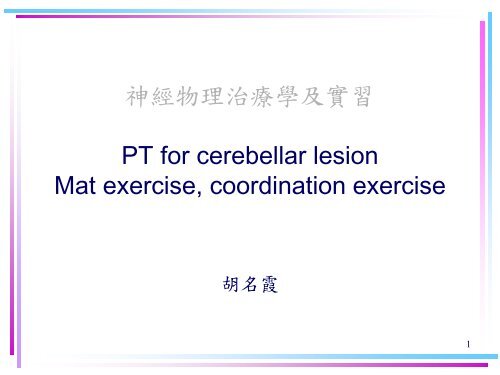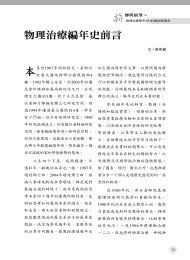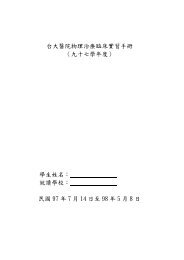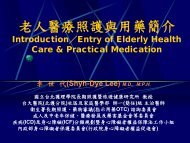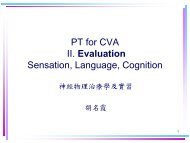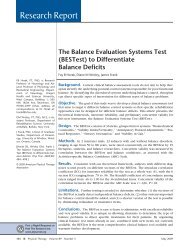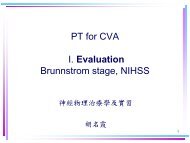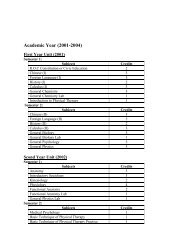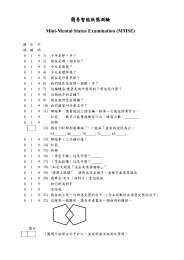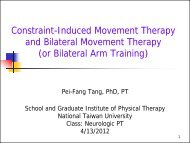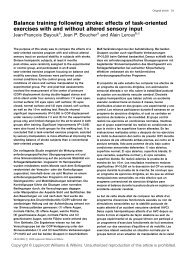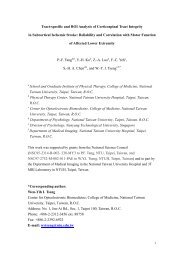ç¥ç¶ç©çæ²»çå¸åå¯¦ç¿ PT for cerebellar lesion Mat exercise ...
ç¥ç¶ç©çæ²»çå¸åå¯¦ç¿ PT for cerebellar lesion Mat exercise ...
ç¥ç¶ç©çæ²»çå¸åå¯¦ç¿ PT for cerebellar lesion Mat exercise ...
Create successful ePaper yourself
Turn your PDF publications into a flip-book with our unique Google optimized e-Paper software.
神 經 物 理 治 療 學 及 實 習<br />
<strong>PT</strong> <strong>for</strong> <strong>cerebellar</strong> <strong>lesion</strong><br />
<strong>Mat</strong> <strong>exercise</strong>, coordination <strong>exercise</strong><br />
胡 名 霞<br />
1
Cerebellum<br />
• Vestibulocerebellum<br />
(archicerebellum),<br />
fastigial n.<br />
• Spinocerebellum<br />
(paleocerebellum)<br />
interpositus→red n<br />
• Cerebropontocerebell<br />
um (neocerebellum),,<br />
dentate → thalamus<br />
(Goldberg, 1983)<br />
2
Deep nucleus of cerebellum<br />
(http://www.vh.org/adult/provider/anatomy/BrainAnatomy/Ch3Text/Section<br />
08.html)<br />
1. Decussation of superior<br />
<strong>cerebellar</strong> peduncles<br />
2. Superior <strong>cerebellar</strong> peduncle<br />
3. Superior medullary velum<br />
4. Fastigial nucleus<br />
5. Globose nuclei<br />
6. Emboli<strong>for</strong>m nucleus<br />
7. White matter of vermis<br />
8. Dentate nucleus<br />
3
Cerebellar peduncles<br />
(http://thalamus.wustl.edu/course/cerebell.html)<br />
4
Primary function of cerebellum<br />
Regulation of:<br />
• Postural control: vestibulocerebellum<br />
• Eye movement: cerebropontocerebellum<br />
• Voluntary movement, mental rehearsal,<br />
perception of timing : cerebropontocerebellum and<br />
spinocerebellum<br />
• Proprioceptive input integration (Muscle tone):<br />
spinocerebellum<br />
Motor learning: all areas<br />
Cognitive and affective function: Cerebellar Cognitive<br />
Affective Syndrome (CCAS, Schmahmann, 2004 )<br />
5
Supplementary:<br />
http://www.robotic.dl<br />
r.de/Smagt/research/c<br />
erebellum/cerebellum<br />
.html<br />
7
Cerebellar diseases<br />
(http://neuro.psychiatryonline.org/cgi/content/full/16/3/367)<br />
• Head trauma<br />
• CVA<br />
• Degenerative diseases: Multiple<br />
sclerosis, inherited disorders<br />
(spino<strong>cerebellar</strong> ataxia, SCA)<br />
• Tumor<br />
• Alcoholism<br />
8
Hain, 2009 (http://www.dizziness-andbalance.com/disorders/central/<strong>cerebellar</strong>/<strong>cerebellar</strong>.htm)<br />
9
Impairments<br />
• Balance<br />
– vestibulocerebellum, fastigial nucleus <strong>lesion</strong>s<br />
– Increased postural sway, delayed equilibrium reactions<br />
• Hypotonicity<br />
– Spinocerebellum; ↓fusimotor activity<br />
– Pendulum test positive, DTR typically normal<br />
• Dysmetria<br />
(http://www.youtube.com/watch?v=jnQcKAYNuyk&NR=1)<br />
– interposed or dentate nuclei cooling<br />
– a deficit in reaching a target, usually a past pointing<br />
(over-shooting)<br />
10
Impairments<br />
• Movement decomposition<br />
– Dentate cooling<br />
• dysdiadochokinesia<br />
– Dentate cooling, Purkinje in the intermediate zone<br />
less inhibited<br />
– Unable to per<strong>for</strong>m rapidly alternating movements<br />
• Asthenia<br />
– Loss of <strong>cerebellar</strong> facilitation to the motor<br />
cortex;↓fusimotor activity<br />
– Generalized weakness (malaise) by 50% on<br />
involved limb<br />
11
Impairments<br />
• ataxia<br />
– Cerebellar link with rubrospinal, reticulospinal,<br />
vestibulospinal tracts; lack of postural control<br />
– In the trunk, extremities, head, mouth, tongue<br />
– Ataxic gait (uneven step length, irregular width,<br />
absent rhythm, highly lifted feet) is most<br />
frequently seen symptom of <strong>cerebellar</strong> patients<br />
– Ataxic gait without limb movement, muscle tone,<br />
balance impairment: anterior <strong>cerebellar</strong> <strong>lesion</strong><br />
12
impairment<br />
• Tremor (class reference)<br />
– Dentate cooling<br />
– 3-5 Hz intention tremor<br />
– Disrupt proprioceptive feedback loop may<br />
lead to postural tremor<br />
• dysarthria<br />
– 8.5% to 19% of <strong>cerebellar</strong> patients, higher<br />
in left <strong>cerebellar</strong> <strong>lesion</strong><br />
13
impairment<br />
• Ocular dysmetria<br />
– Flocculus, paraflocculus of posterior vermis;<br />
fastigial nucleus<br />
– Unable to move eye accurately to peripheral<br />
targets; saccade too large or too small<br />
• Gaze-evoked nystagmus<br />
• VOR dysfunction<br />
• Optokinetic nystagmus (revolving drum test)<br />
14
Schmahmann JD, Sherman JC: The <strong>cerebellar</strong><br />
cognitive affective syndrome. Brain 1998; 121:561–579<br />
15
Differential diagnosis<br />
• Spinal cord posterior column <strong>lesion</strong>:<br />
sensory ataxia, tabetic ataxia<br />
– Romberg test<br />
• Multiple sclerosis<br />
– Other systems symptom<br />
– Muscle tone<br />
• Basal ganglia <strong>lesion</strong><br />
– Resting vs. intention tremor<br />
16
Recovery from <strong>cerebellar</strong> <strong>lesion</strong>s<br />
• Single <strong>cerebellar</strong> hemisphere involve without<br />
nuclear damage: better recovery (about 2<br />
months)<br />
• More severe involvement: expect recovery<br />
process to plateau within 6-12 months<br />
• Slow movement recover better than fast<br />
movement<br />
• Complex movement also recovers<br />
• Rehabilitation is effective (Topka, 1998;Isaacs et al,<br />
1992;Klintsova et al, 2000)<br />
17
Principles of assessment<br />
Reading:<br />
Umphred, p. 729-30<br />
table)<br />
• Observe basic mobility<br />
– Evaluate both sides<br />
– Assistant needed<br />
– Time to completion<br />
– Safety<br />
– Incoordination/amount of ef<strong>for</strong>t<br />
• Cerebellar <strong>lesion</strong>: symptoms usually unilateral<br />
on the same side<br />
• Consider other factors: sensation, muscle<br />
strength, ROM<br />
• Quantify<br />
18
Non-equilibrium coordination tests<br />
• Finger to nose<br />
• Finger to therapist’s finger<br />
• Finger to finger<br />
• Finger nose finger (alternate nose to<br />
finger), FNF test<br />
– Sec / 5 reps<br />
19
Finger-to-nose test (Feys et al., 2003)<br />
• Observe intention tremor<br />
21
Non-equilibrium coordination tests<br />
• Finger opposition<br />
• Mass grasp<br />
• Pronation/supination<br />
• Rebound test<br />
• Tapping (hand)<br />
22
Non-equilibrium coordination tests<br />
• Tapping (foot)<br />
• Alternate heel to knee; heel to toe<br />
• Heel on shin (heel shin test)<br />
• Drawing a circle<br />
• Fixation or position holding<br />
23
Equilibrium coordination test<br />
• Normal stance<br />
• Romberg test<br />
• Tandem stance<br />
• One leg stance<br />
• Start and stop abruptly<br />
• Walk on heels/toes<br />
• Tandem walk<br />
• Walk with head turns…..<br />
25
Tests <strong>for</strong> coordination impairments<br />
• Dysdiadochokinesia<br />
– Finger nose finger test<br />
– Pronation/supination<br />
– Knee flexion/extension<br />
– Tapping<br />
– Walking, alter speed or duration<br />
26
Tests <strong>for</strong> coordination impairments<br />
• Dysmetria<br />
– Finger nose finger test<br />
– Finger to therapist’s finger<br />
– Drawing a circle<br />
– Heel on shin<br />
– Placing feet on floor markers while walking<br />
27
Tests <strong>for</strong> coordination impairments<br />
• Movement decomposition<br />
– Finger nose finger<br />
– Alternate heel to knee<br />
28
Tests <strong>for</strong> coordination impairments<br />
• Postural Tremor<br />
– Normal stance<br />
– Position holding<br />
• Intention tremor<br />
– Observe during functional movement<br />
– Finger nose finger test<br />
29
Standardized tests<br />
• Jebsen-Taylor hand function test<br />
• Minnesota rate of manipulation test<br />
• Purdue Pegboard test<br />
• Craw<strong>for</strong>d small parts dexterity test<br />
30
Purdue pegboard<br />
31
Principle of Training<br />
• Repetition, repetition, repetition!<br />
• Postural stability<br />
• Functional transfers and gait<br />
• Accuracy of limb movement during activities<br />
– PNF practice be<strong>for</strong>e functional movement (Kabat,<br />
1950; Kabat, 1955)<br />
– Frenkel <strong>exercise</strong> (since 1889; Nakamura & Taniguchi, 1978)<br />
– Add weight, Theraband, air splints, soft neck<br />
collar, pool<br />
32
Head and trunk control<br />
• For cerebeller <strong>lesion</strong>:<br />
– Prone<br />
– Sit, <strong>for</strong>ward lean with elbow on pillow<br />
(Umphred, p. 731)<br />
33
Frenkel Exercises: Principles<br />
• Caliet 1899 (cited in Licht, 1965)<br />
• Originally <strong>for</strong> LE, to↓dysmetria<br />
• Supine, sit, stand, walk<br />
• Supported then unsupported<br />
• Unilateral then bilaterally<br />
• Eyes open then closed<br />
• With rhythm, count out loud<br />
• Slow then to start and stop on commands<br />
• accurate (to targets) and repetition<br />
• Increasing range; add weight then no weight<br />
• Followed by functional activities<br />
34
Frenkel <strong>exercise</strong>s (1)<br />
• Supine-per<strong>for</strong>m with eyes closed<br />
– Flex and extend one leg, heel sliding down<br />
a straight line on table<br />
– Abduct and adduct hip smoothly with knee<br />
bent, heel on table<br />
– Abduct and adduct leg with knee and hip<br />
extended, leg sliding on table<br />
– Flex and extend hip and knee with heel off<br />
table<br />
35
Frenkel <strong>exercise</strong> (2)<br />
• Supine<br />
– Place one heel on knee of opposite leg and<br />
slide heel smoothly down shin toward<br />
ankle and back to knee<br />
– Flex and extend both legs together, heels<br />
sliding on table<br />
– Flex one leg while extending other leg<br />
– Flex and extend one leg while abducting<br />
and adducting other leg<br />
36
Frenkel <strong>exercise</strong> (3)<br />
• Sitting<br />
– Place foot in therapist’s hand, which will<br />
change position on each trial<br />
– Raise leg and put foot firmly on traced<br />
footprint on floor<br />
– Sit steady <strong>for</strong> a few minutes<br />
– Rise and sit with knees together<br />
37
Frenkel <strong>exercise</strong> (4)<br />
• Standing<br />
– Place foot <strong>for</strong>ward and backward on a<br />
straight line<br />
– Walk along a winding strip<br />
– Walk between two parallel lines<br />
– Walk, placing each foot in a tracing on floor<br />
38
Frenkel <strong>exercise</strong> (5)<br />
• Walking: sideways <strong>for</strong> <strong>for</strong>ward to a<br />
specified count (may use targets on the<br />
floor)<br />
• Walking: turn around to a specified<br />
count.<br />
39
Guiding<br />
• Guided movement therapy by Patricia<br />
Davies (Steps to Follow, 2000)<br />
• Task-oriented and handling<br />
• Augmented in<strong>for</strong>mation<br />
• Motivation is dependent upon the<br />
suitability of the task and the way in<br />
which the therapist guides the patient (p.<br />
20, Davies, 2000)<br />
• Guiding when giving assistance<br />
40
placing<br />
43
<strong>Mat</strong> Activities<br />
• Learns to move again, feeling in contact<br />
with the firm surface<br />
• Better orient the body segments and<br />
limbs while moving<br />
• For fear of falling: patient learns to get<br />
down to the floor and come back up,<br />
helps to become familiar with the<br />
distance down to the floor<br />
44
First time down to the floor
More experience –<br />
Affected knee down<br />
first<br />
46
L’t hemi: kneel to R’t side sitting<br />
47
Turn to L’t side sitting
Long sitting<br />
50
Long sitting <strong>for</strong> sever patients<br />
51
Scapular protraction<br />
52
Lying down and sitting up<br />
with trunk rotation
Trunk rotation<br />
54
idging
Half arm and foot splint in prone lying<br />
56
Patient with<br />
tracheostomy<br />
57
Prone kneeling<br />
59
crawling<br />
Watch UE rotation<br />
60
crawling<br />
Watch UE rotation<br />
61
kneeling<br />
62
Half kneeling on affected side<br />
63
Standing up from floor<br />
64
Case reports on line<br />
http://www.thefreelibrary.com/Rehabilitation+of+balance+in+two+patients+<br />
with+<strong>cerebellar</strong>+dysfunction.-a019441043<br />
• Patient 1--Cerebellar Dysfunction After<br />
Removal of a Cerebellar Tumor<br />
• Patient 2--Cerebellar Dysfunction Due<br />
to Cerebrotendinous Xanthomatosis<br />
65
Evidence-based (self study)<br />
• Martin CL, Tan D, Bragge P,<br />
Bialocerkowski A. 2009.<br />
Effectiveness of physiotherapy <strong>for</strong><br />
adults with <strong>cerebellar</strong> dysfunction: a<br />
systematic review. Clinical<br />
Rehabilitation 23(1):15-26.<br />
66
Alcoholism<br />
• Neurological signs-cortical and<br />
<strong>cerebellar</strong> dysfunction<br />
• vitamin and nutritional deficiency-PNS<br />
deficiency<br />
• Acute alcohol intoxication: reversible<br />
– Passes out with hangover<br />
– Drinking water and eating alleviate<br />
symptoms<br />
67
Chronic alcoholism<br />
• Ataxia of trunk and Les<br />
• Incoordination<br />
• Peripheral neuropathy<br />
• Seizure<br />
• Vestibular deficit<br />
• Psychological problems: delirium<br />
tremens (DTs), dementia, Wernicke-<br />
Korsakoff syndrome<br />
68
Alcoholism-evaluation<br />
• Mental status: MMSE<br />
• Peripheral nerve function: sensation,<br />
muscle strength, NCV<br />
• Cerebellar function: balance<br />
• VOR, nystagmus<br />
69
Alcoholism-treatment consideration<br />
• Memory and attention may be impaired,<br />
thus goal setting and learning skills<br />
hampered<br />
• Prognosis difficult to predict<br />
• General debilitated: progressive<br />
reconditioning program effective<br />
(Tsukue, Shohaji, 1981)<br />
70
自 閉 症 與 小 腦<br />
• 自 閉 症 的 主 要 症 狀 : 社 交 缺 失 ; 但 往 往 也<br />
有 運 動 失 調 ( 小 腦 ) 症 狀<br />
71


